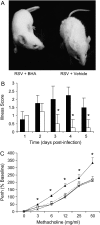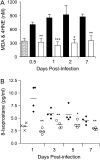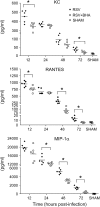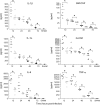Antioxidant treatment ameliorates respiratory syncytial virus-induced disease and lung inflammation
- PMID: 17008643
- PMCID: PMC2648297
- DOI: 10.1164/rccm.200603-319OC
Antioxidant treatment ameliorates respiratory syncytial virus-induced disease and lung inflammation
Abstract
Rationale: Respiratory syncytial virus (RSV) is a major cause of lower respiratory tract infection in children. No treatment has been shown to significantly improve the clinical outcome of patients with this infection. Recent evidence suggests that oxidative stress could play an important role in the pathogenesis of acute and chronic lung inflammatory diseases. We do not known whether RSV induces pulmonary oxidative stress and whether antioxidant treatment can modulate RSV-induced lung disease.
Objectives: To investigate the effect of antioxidant administration on RSV-induced lung inflammation, clinical disease, and airway hyperreactivity (AHR).
Methods: BALB/c mice were infected with 10(7) plaque-forming units of RSV, in the presence or absence of orally administered butylated hydroxyanisole (BHA), an antioxidant. Malondialdehyde and 4-hydroxynonenal were measured in bronchoalveoar lavage (BAL) by colorimetric assay. Cytokines and chemokines were measured in BAL by Bio-Plex and leukotrienes were measured by enzyme-linked immunosorbent assay. AHR to methacholine challenge was measured by whole-body plethysmography.
Results: BHA treatment significantly attenuated RSV-induced lung oxidative stress, as indicated by the decrease of malondialdehyde and 4-hydroxynonenal content in BAL of RSV-infected mice. RSV-induced clinical illness and body weight loss were also reduced by BHA treatment, which inhibited neutrophil recruitment to the lung and significantly reduced pulmonary cytokine and chemokine production after RSV infection. Similarly, antioxidant treatment attenuated RSV-induced AHR.
Conclusion: Modulation of oxidative stress represents a potential novel pharmacologic approach to ameliorate RSV-induced acute lung inflammation and potentially prevent long-term consequences associated with RSV infection, such as bronchial asthma.
Figures









Similar articles
-
Inhibitory effect of melatonin on lung oxidative stress induced by respiratory syncytial virus infection in mice.J Pineal Res. 2010 Mar;48(2):109-16. doi: 10.1111/j.1600-079X.2009.00733.x. Epub 2010 Jan 8. J Pineal Res. 2010. PMID: 20070490
-
Role of cysteinyl leukotrienes in airway inflammation and responsiveness following RSV infection in BALB/c mice.Pediatr Allergy Immunol. 2005 Nov;16(7):593-601. doi: 10.1111/j.1399-3038.2005.00248.x. Pediatr Allergy Immunol. 2005. PMID: 16238585
-
Ultrafine carbon black particles enhance respiratory syncytial virus-induced airway reactivity, pulmonary inflammation, and chemokine expression.Toxicol Sci. 2003 Apr;72(2):339-46. doi: 10.1093/toxsci/kfg032. Epub 2003 Mar 7. Toxicol Sci. 2003. PMID: 12655033
-
Respiratory syncytial virus persistence: evidence in the mouse model.Pediatr Infect Dis J. 2008 Oct;27(10 Suppl):S60-2. doi: 10.1097/INF.0b013e3181684d52. Pediatr Infect Dis J. 2008. PMID: 18820580 Review.
-
Contribution of neuroimmune mechanisms to airway inflammation and remodeling during and after respiratory syncytial virus infection.Pediatr Infect Dis J. 2003 Feb;22(2 Suppl):S66-74; discussion S74-5. doi: 10.1097/01.inf.0000053888.67311.1d. Pediatr Infect Dis J. 2003. PMID: 12671455 Review.
Cited by
-
Ozone-Induced Oxidative Stress, Neutrophilic Airway Inflammation, and Glucocorticoid Resistance in Asthma.Front Immunol. 2021 Feb 26;12:631092. doi: 10.3389/fimmu.2021.631092. eCollection 2021. Front Immunol. 2021. PMID: 33717165 Free PMC article. Review.
-
Intravenous vitamin C for reduction of cytokines storm in acute respiratory distress syndrome.PharmaNutrition. 2020 Jun;12:100190. doi: 10.1016/j.phanu.2020.100190. Epub 2020 Apr 21. PharmaNutrition. 2020. PMID: 32322486 Free PMC article. Review.
-
Role of hydrogen sulfide in paramyxovirus infections.J Virol. 2015 May;89(10):5557-68. doi: 10.1128/JVI.00264-15. Epub 2015 Mar 4. J Virol. 2015. PMID: 25740991 Free PMC article.
-
Global Profiling of the Antioxidant Constituents in Chebulae Fructus Based on an Integrative Strategy of UHPLC/IM-QTOF-MS, MS/MS Molecular Networking, and Spectrum-Effect Correlation.Antioxidants (Basel). 2023 Dec 8;12(12):2093. doi: 10.3390/antiox12122093. Antioxidants (Basel). 2023. PMID: 38136213 Free PMC article.
-
The possible importance of the antioxidants and oxidative stress metabolism in the emerging monkeypox disease: An opinion paper.Front Public Health. 2022 Oct 20;10:1001666. doi: 10.3389/fpubh.2022.1001666. eCollection 2022. Front Public Health. 2022. PMID: 36339207 Free PMC article. No abstract available.
References
-
- Hall CB. Respiratory syncytial virus: a continuing culprit and conundrum. J Pediatr 1999;135:2–7. - PubMed
-
- Glezen WP, Taber LH, Frank AL. Risk of primary infection and reinfection with respiratory syncytial virus. Am J Dis Child 1986;140:543–546. - PubMed
-
- Groothuis JR, Gutierre KM, Lauer BA. Respiratory syncytial virus infection in children with bronchopulmonary dysplasia. Pediatrics 1988;82:199–203. - PubMed
-
- Sigurs N, Bjarnason R, Sigurbergsson F, Kjellman B, Bjorksten B. Asthma and immunoglobulin E antibodies after respiratory syncytial virus bronchiolitis: a prospective cohort study with matched controls. Pediatrics 1995;95:500–505. - PubMed
-
- Garofalo RP, Haeberle H. Epithelial regulation of innate immunity to respiratory syncytial virus. Am J Respir Cell Mol Biol 2000;23:581–585. - PubMed
Publication types
MeSH terms
Substances
Grants and funding
LinkOut - more resources
Full Text Sources
Other Literature Sources
Medical

